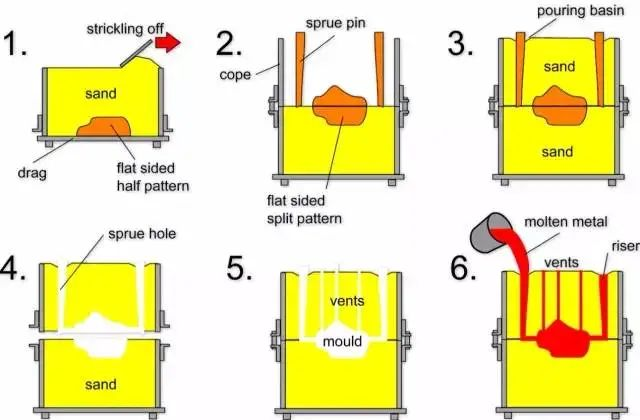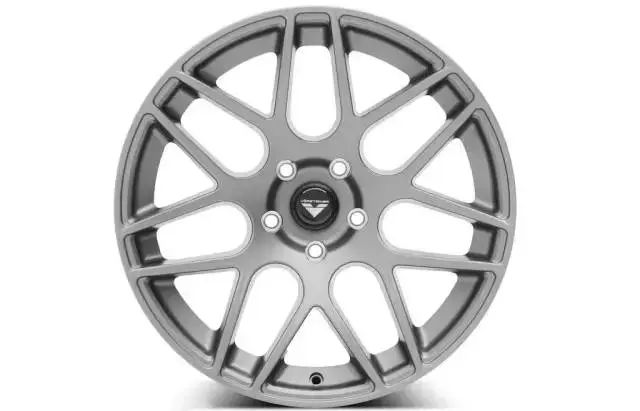technological innovation
Aluminum alloy die casting process introduction (1)
liquid metal to part shape size phase size phase mold mold mold to let it solidify to cool to get get get get get cavity cavity cavity cavity get mold mold
Process flow: liquid metal → filling → solidification shrinkage → casting

Process features:
1. It can produce parts with arbitrary complex shapes, especially those with complex inner cavity shapes.
2. Strong adaptability, unlimited types of alloys, almost unlimited size of castings.
3. The source of materials is wide, the waste products can be remelted, and the equipment investment is low.
4. High scrap rate, low surface quality and poor working conditions.
Casting classification:
(1) Sand Casting

Sand casting: A casting method in which castings are produced in sand molds. Steel, iron and most non-ferrous alloy castings can be obtained by sand casting.
Process flow:

Technical Features:
1. It is suitable for making blanks with complex shapes, especially with complex inner cavities;
2. Wide adaptability and low cost;
3. For some materials with poor plasticity, such as cast iron, sand casting is the only forming process for manufacturing its parts or blanks.
Application: Engine cylinder block, cylinder head, crankshaft and other castings of automobiles
(2) Investment Casting

Investment casting: usually refers to making a pattern from a fusible material, coating several layers of refractory material on the surface of the pattern to make a shell, and then melting the pattern to discharge the shell, so as to obtain a mold without a parting surface, which is roasted at high temperature The casting scheme that can be filled with sand after pouring. Often referred to as "lost wax casting".
Investment Casting Process
Process characteristics
advantage:
1. High dimensional accuracy and geometric accuracy;
2. High surface roughness;
3. It can cast castings with complex shapes, and the casting alloys are not limited.
Disadvantages: complicated process and high cost
Application: It is suitable for the production of small parts with complex shapes, high precision requirements, or difficult other processing, such as blades of turbine engines, etc.
(3)Die Casting

Die casting: It uses high pressure to press molten metal into a precision metal mold cavity at high speed, and the molten metal is cooled and solidified under pressure to form a casting.
Process flow:
1. Debugging of die casting machine
2. Die casting mold installation
3. Die-casting mold design and manufacture
5. Coating preparation
4. Mold preheating, coating
7. Closing (mold closing)
6. Mold cleaning
8. Alloy melting and heat preservation
10. Pouring injection
9. Insert preparation
11. Holding pressure
12. Mold opening and core pulling
Process characteristics
advantage:
1. During die-casting, the metal liquid bears high pressure and the flow rate is fast
2. Good product quality, stable size and good interchangeability;
3. The production efficiency is high, and the die-casting mold can be used frequently;
4. It is suitable for mass production and has good economic benefits.
shortcoming:
1. Castings are prone to tiny pores and shrinkage.
2. Die castings have low plasticity, so it is not suitable to work under impact load and vibration;
3. When die-casting high-melting point alloys, the life of the mold is low, which affects the expansion of die-casting production.
Application: Die castings were first used in the automobile industry and the instrument industry, and then gradually expanded to various industries, such as agricultural machinery, machine tool industry, electronics industry, defense industry, computer, medical equipment, clocks, cameras, daily hardware and other industries .
(4)Low pressure casting

Low-pressure casting: refers to the method of filling the mold with liquid metal under the action of low pressure (0.02-0.06MPa) and crystallizing under pressure to form castings.
Process flow:
Technical Features:
1. The pressure and speed during pouring can be adjusted, so it can be applied to various casting molds (such as metal molds, sand molds, etc.), casting various alloys and castings of various sizes;
2. Bottom injection type filling is adopted, the molten metal filling is stable without splashing, which can avoid the gas involved and the erosion of the mold wall and core, and improve the qualified rate of castings;
3. The casting crystallizes under pressure, the casting structure is dense, the outline is clear, the surface is smooth, and the mechanical properties are high, which is especially beneficial for the casting of large and thin-walled parts;
4. The feeding riser is omitted, and the metal utilization rate is increased to 90-98%;
5. Low labor intensity, good working conditions, simple equipment, easy to realize mechanization and automation.
Application: mainly traditional products (cylinder head, wheel hub, cylinder frame, etc.).
(5)Centrifugal Casting

Centrifugal casting: It is a casting method in which molten metal is poured into a rotating mold, and the mold is filled and solidified under the action of centrifugal force.
Process flow:
Process characteristics
advantage:
1. There is almost no metal consumption in the pouring system and riser system, which improves the process yield;
2. There is no need for a core when producing hollow castings, so the metal filling ability can be greatly improved when producing long tubular castings;
3. The casting has high density, fewer defects such as pores and slag inclusions, and high mechanical properties;
4. It is convenient to manufacture composite metal castings such as barrels and sleeves.
shortcoming:
1. There are certain limitations when used to produce special-shaped castings;
2. The diameter of the inner hole of the casting is not accurate, the surface of the inner hole is relatively rough, the quality is poor, and the machining allowance is large;
3. Castings are prone to specific gravity segregation.
application:
Centrifugal casting was first used to produce cast pipes. At home and abroad, centrifugal casting technology is used in metallurgy, mining, transportation, drainage and irrigation machinery, aviation, national defense, automobile and other industries to produce steel, iron and non-ferrous carbon alloy castings. Among them, the production of castings such as centrifugal cast iron pipes, internal combustion engine cylinder liners and shaft sleeves is the most common.
RELATED NEWS
- Not sure about the T4, T5, and T6 materials of aluminum profiles? This article h 2024-03-20
- How to use aluminum profile section design skills to solve extrusion production 2024-03-19
- Factors affecting the life of trimming and punching molds 2024-03-12
- Overview of Steel/Aluminum Welding Technology 2024-02-29
- Steel belt conveying direction 2023-09-26
CATEGORIES
LATEST NEWS
CONTACT US
Contact: Manager:Miss Jasmien
Phone: +8618825429836
E-mail: info@gdaa-cn.com
Whatsapp:+8618825429836
Add: Headquarter:No.8,Yixian Road,GDAA Mansion,Guangfo Zhicheng, Dali Town,Foshan,Guangdong.China
